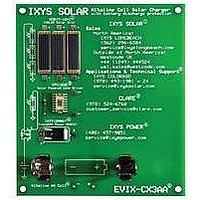EVIX-CX3AA IXYS-DIRECTED ENERGY, EVIX-CX3AA Datasheet - Page 2

EVIX-CX3AA
Manufacturer Part Number
EVIX-CX3AA
Description
Solar Charger Evaluation Board
Manufacturer
IXYS-DIRECTED ENERGY
Datasheet
1.EVIX-CX3AA.pdf
(8 pages)
Specifications of EVIX-CX3AA
Silicon Manufacturer
IXYS Solar
Silicon Core Number
XOB17-12x1
Kit Application Type
Power Management - Battery
Application Sub Type
Battery Charger
SolarBIT Description
XOB17-12x1 SolarBITs are monocrystalline, high-efficiency solar cells in a surface mount package that can
be reflow soldered. They’re extremely robust and can be used in harsh environments.
SolarBITs have a very high (17%) power conversion efficiency, which means that 17% of the light energy is
converted into electrical energy. They’re extremely useful in applications requiring solar power generation in
a limited space.
IXYS cells can be used in indoor and outdoor applications because they have a wide spectral sensitivity, 300
to 1100 nm. However, the output power of a solar cell is proportional (over a wide range) to the incoming
light energy, and irradiance is generally much higher outdoors. The values in the data sheet are measured
at “standard condition” of 1 sun, which is equal to 1000W per square meter sunlight irradiance at a defined
light spectrum (air mass of 1.5) and 25°C cell temperature.
The SolarBIT comes in several different voltage and current configurations. Please see the website for
further information. www.ixys.com
Background
Some basic information needs to be covered to better understand what to expect in terms
of the evaluation board’s performance with regards to solar cell type, lighting conditions in
terms of power density, and general industry standards as they relate to battery charging.
Types of Silicon Solar Cells
Polycrystalline (multicrystalline) solar cells are cut from multifaceted silicon crystal
resulting in inherent flaws. They have lower power conversion efficiency (12-13%)
than monocrystalline cells. They’re commonly found in outdoor applications and have
a spectral sensitivity range of 500 to 1100 nm. Polycrystalline cells have a “flaked” or
“shattered” appearance.
Monocrystalline cells are cut from a single grown crystal of silicon. They have higher
power conversion efficiency (15-19%) than polycrystalline and are more expensive to
manufacture because of the complicated crystal growth process involved. With a wide
spectral sensitivity range of 300 nm (near-ultraviolet) to 1100 nm (near-infrared), which
includes the visible light spectrum (400 to 700 nm), they can be used both indoors and
outdoors. Monocrystalline cells have a uniform dark blue or dark grey appearance.
Amorphous cells are not crystalline but instead created by applying a thin layer of silicon
directly onto various materials such as glass or metal. Amorphous have low power
conversion efficiency (5%) and suffer from light-induced degradation that reduces output
10% or more in the first 100 hours of operation. With a spectral sensitivity range of 300
to 600 nm they are not sensitive to the upper light spectrum and cannot take advantage
of natural sunlight. They’re commonly used indoors in very low power products such as
calculators and clocks.
IXYS SolarBITs are monocrystalline cells made of float zone silicon that has far fewer
impurities than standard CZ silicon. The result is a solar cell with the best combination of
efficiency and spectrum sensitivity for indoor and outdoor use.
-2-
SOLAR
SOLAR











